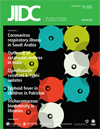Coronavirus respiratory illness in Saudi Arabia
DOI:
https://doi.org/10.3855/jidc.3084Keywords:
Coronavirus, Saudi Arabia, Respiratory disease, Hajj SeasonAbstract
Although viruses that belong to the coronavirus family are known since the 1930s, they only gained public health attention when they were discovered to be the causative agent of the severe acute respiratory syndrome (SARS) outbreak in China in 2002–2003. On 22 September 2012, the Ministry of Health (MOH) in Saudi Arabia announced the detection of what was described as a “rare pattern” of coronavirus respiratory infection in three individuals, two Saudi citizens and one person from the Gulf Region. Neither Saudi citizen survived the infection. Molecular analysis of the isolates showed that the virus belongs to the genus beta-coronavirus. It is not known if the new isolates are circulating in the population or has recently diverged. The emergence of these novel isolates that resulted in fatal human infection ascertains that health authorities all over the world must be vigilant for the possibility of new global pandemics due to novel viral infection.
Downloads
Published
How to Cite
Issue
Section
License
Authors who publish with this journal agree to the following terms:
- Authors retain copyright and grant the journal right of first publication with the work simultaneously licensed under a Creative Commons Attribution License that allows others to share the work with an acknowledgement of the work's authorship and initial publication in this journal.
- Authors are able to enter into separate, additional contractual arrangements for the non-exclusive distribution of the journal's published version of the work (e.g., post it to an institutional repository or publish it in a book), with an acknowledgement of its initial publication in this journal.
- Authors are permitted and encouraged to post their work online (e.g., in institutional repositories or on their website) prior to and during the submission process, as it can lead to productive exchanges, as well as earlier and greater citation of published work (See The Effect of Open Access).








